—>Dashiell sees the documentary film about stained glass artist Rowan LeCompte and the artisans who worked with him on a commission for the National Cathedral in Washington, D.C., and says we will all come away with a new appreciation of the medium after watching the movie. –the Artblog editors————>
Peter Swanson, the director of the new documentary “Let There Be Light”, spent six years behind the camera to tell the story of Rowan LeCompte, a master stained-glass artist who has been honing his craft for the past 70 years, and his work on the National Cathedral in Washington D.C. The film follows its subject as he is commissioned to design a series of lancet windows and a rose window for the National Cathedral, following the acclaim given to the west Rose Window (a work described as “the most beautiful window in all of Christendom”) he designed in the same space. The film also dedicates substantial time to following Dieter Goldkuhle, a German glass artisan, who worked closely with LeCompte for decades, crafting Rowan’s intricate patterns and Biblical imagery from sheets of vibrant glass, and to Mary Clerkin Higgins, who took over from Dieter when he left this final project to pursue other commitments. Garrison Keillor provides somewhat stilted and droning narration, but his voice-overs are thankfully infrequent and brief, used only to fill in the occasional historical detail or advance the story more efficiently.
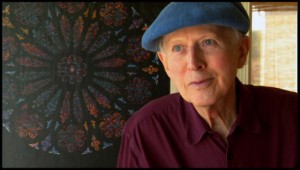
Swanson spends a good deal of time filling in LeCompte’s backstory. The artist got his first commission at 16 and quickly gained admiration for his bold, modern approach to the artform. While many traditionalists felt stained glass windows should be muted and restful, LeCompte’s windows are more often richly hued and sparkling with color, with a greater focus on patterns than literal imagery.
The artist and his history
It’s hard not to get caught up in LeCompte’s charming, passionate discussion of his past, his inspirations, and his craft, so earnest and genuine is his love for his medium. For LeCompte, his art is a never-ending experiment, demanding an openness to new possibilities and unexpected turns. We see the respect and deference Mary Clerkin Higgins and Dieter Goldkuhle have for LeCompte, and it’s clear why they feel this way – LeCompte is an exacting perfectionist and a passionate artist, who nonetheless remains a humble and generous collaborator.
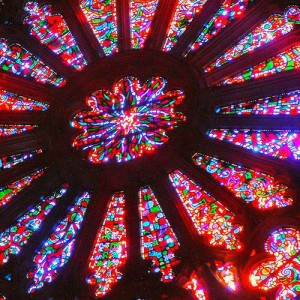
The artisans on the project
Dieter Goldkuhle similarly comes across as a passionate artisan (“I’m not an artist,” he insists) who has devoted his life to his craft. His job is to select glass, cut it, piece it together and, once LeCompte has painted the panels, to fire it. We see him engaging in each of these steps, and stop briefly in the glassworks in Germany he sources from, where panes of glass in every hue imaginable are handcrafted in what Goldkuhle calls “a ballet around a furnace.” Goldkuhle is thrilled by “the magic of glass and the relationship it has with light,” and is clearly in love with the medium.
It’s nice to see Goldkuhle and LeCompte interacting, as well, in part because it offers insight into how time consuming stained-glass production can be, but also to see how a true collaborative spirit can yield the best results. There are moments of tension between the men, but ultimately their respect for one another is the dominant force behind their 4-decade long collaboration. Goldkuhle left the National Cathedral Project in 2009 after four years of working on it, and passed away in 2011 before it had been completed.
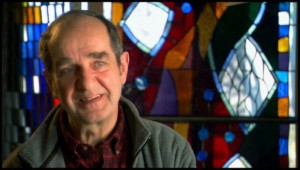
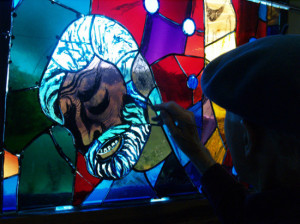
The commission runs into trouble
Unfortunately for LeCompte and the other artists and artisans involved, a committee at the National Cathedral was not happy with the windows finally submitted in 2011, 4 years behind schedule, and chose not to install them. LeCompte, his wife, and Higgins all argued that the committee had only seen photographs of the windows and thus could not possibly know how they would look once installed in the space. Although the committee finally agreed to install the two side lancet windows, the two central lancets and the rose window remain uninstalled in the space. The film ends on a somewhat melancholy note, with no resolution as to whether these pieces might be given a second chance. Nonetheless, LeCompte remains undaunted. He may be disappointed, but his enthusiasm and love for his craft is unshaken.
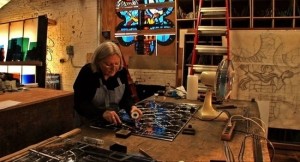
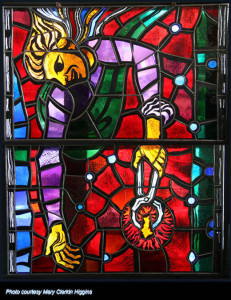
The movie has wide appeal
“Let There Be Light” should appeal to a wide audience. Glass blowers and glass artists will appreciate the great reverence and respect Swanson treats the medium with, while neophytes will be engaged by masters of the trade explaining their techniques, gaining an entirely new appreciation for stained glass in the process. Even those not especially interested in the medium itself will likely find themselves drawn in by the passion and intelligence of the artists and artisans, who Swanson wisely allows to speak for themselves with little narration or directorial intervention. Don’t be fooled by the somewhat melodramatic trailer (below) – “Let There Be Light” is a sensitive and engaging exploration of an often-ignored art form and a handful of impassioned men and women who have devoted their lives to it.
“Let There Be Light” was released earlier this year. The DVD can be purchased on the film’s website.





